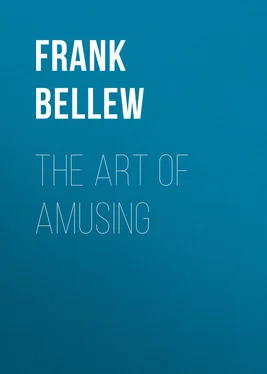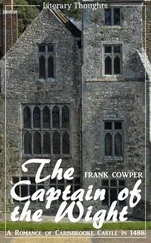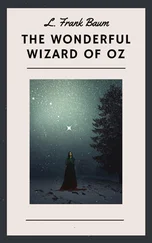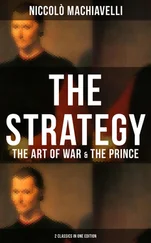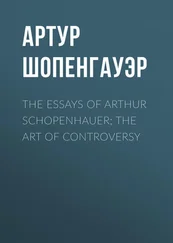Frank Bellew - The Art of Amusing
Здесь есть возможность читать онлайн «Frank Bellew - The Art of Amusing» — ознакомительный отрывок электронной книги совершенно бесплатно, а после прочтения отрывка купить полную версию. В некоторых случаях можно слушать аудио, скачать через торрент в формате fb2 и присутствует краткое содержание. ISBN: , Жанр: foreign_antique, foreign_prose, на английском языке. Описание произведения, (предисловие) а так же отзывы посетителей доступны на портале библиотеки ЛибКат.
- Название:The Art of Amusing
- Автор:
- Жанр:
- Год:неизвестен
- ISBN:http://www.gutenberg.org/ebooks/40309
- Рейтинг книги:3 / 5. Голосов: 1
-
Избранное:Добавить в избранное
- Отзывы:
-
Ваша оценка:
- 60
- 1
- 2
- 3
- 4
- 5
The Art of Amusing: краткое содержание, описание и аннотация
Предлагаем к чтению аннотацию, описание, краткое содержание или предисловие (зависит от того, что написал сам автор книги «The Art of Amusing»). Если вы не нашли необходимую информацию о книге — напишите в комментариях, мы постараемся отыскать её.
The Art of Amusing — читать онлайн ознакомительный отрывок
Ниже представлен текст книги, разбитый по страницам. Система сохранения места последней прочитанной страницы, позволяет с удобством читать онлайн бесплатно книгу «The Art of Amusing», без необходимости каждый раз заново искать на чём Вы остановились. Поставьте закладку, и сможете в любой момент перейти на страницу, на которой закончили чтение.
Интервал:
Закладка:
To produce variety of notes and tones, as well as to speak through it, after the manner of the Punch showmen, the instrument must be placed well back in the mouth near the root of the tongue, in such a position that you can blow through it and at the same time retain free use of your tongue. A little practice will enable you to do this, and to pronounce many words in a tolerably understandable manner. To discover this last item in the use of the instrument, simple as it is, cost the writer of this an infinity of trouble and some money; and it was not until after two years' hunting and inquiry, and the employment of agents to hunt up professors of Punch and Judy, that we discovered an expert who, for a handsome fee, explained the matter; and then, of course, we were amazingly surprised that we had never thought of it before. From the same expert we learned how to make another instrument by means of which it is possible to imitate the note of almost every animal, from the hog to the canary-bird. We soon compassed the hog, the horse, the hen, the dog, the little pig, and something that might be called the horse-linnet, or the hog-canary; but ere long we found that considerable practice was necessary to enable us to accomplish the finer notes of the singing-birds. How to make this latter instrument we will explain in a future chapter; at present we must go on with the play of Punch and Judy.
We commence instructions with a view taken behind the scenes, which will help the description (see cut on page 40). We may state that the London showmen carry about with them a species of little theatre of simple construction, which is of course better than a mere door-way; but as the latter will answer the purpose, and many people will not care to make a theatre, we will at present content ourselves with that which every house affords.
In the play of Punch and Judy there are many characters – indeed, you can introduce almost as great a variety as you please; but the leading ones are:
Mr. Punch, a merry gentleman, of violent and capricious temper.
Judy (wife of Punch).
Baby (offspring of Punch and Judy).
Ghost.
Constable.
The heads of these characters can be made in several ways. The first is to get the necessary number of common round wooden lucifer match-boxes and some red putty. With the putty you make the noses and chins of the characters (all except the Ghost, who requires no nose). With a camel's-hair brush and a little India-ink or black paint you mark out the features strongly, taking care to make the eyes and eyeballs of a good size, so as to be seen at a distance. With a little red paint or red chalk you can color the cheeks, and with a little white paint or white chalk give brilliancy to the teeth and eyes. The annexed cut will show what the style of countenance ought to be of each, No. 1 being the Constable, No. 2 Judy, and No. 3 Mr. Punch himself. The Ghost is not represented. In feature he is much like the Constable, only that his face must be made as white as possible, and the features simply marked out in blue or green or black. The Baby can be made out of an ordinary clothes-pin or stick of wood.
If the match-boxes cannot be easily obtained, just roll up a good-sized card, as represented in this figure, and paint on it the features. The nose and chin can be made of a bit of red rag or paper folded up of the desired shape, and either sewed or gummed on. Another and far better way of making these heads (though it takes more trouble), is to get a carpenter to cut out for you four or five pieces of white pine or other fine wood of the shape of the sketch annexed, with a hole in each large enough to easily admit your fore-finger. From this block you can carve as elaborate a head as you please, and one of larger size than the match-box, which will be advantageous. The diagram marked O will show you how to set about making the carving. Having now made the bald heads, you must proceed to dress them. Punch must have a bright red cap with yellow tassel and binding, like the one in the accompanying sketch. Judy must have a white cap with broad frill and black ribbon. The Constable must have a wig made out of some scrap of fur (the remains of a tippet or cuff), or if fur cannot be procured, a piece of rope unravelled will make a good wig. The Ghost only requires his winding-sheet drawn over his head. All these can be nailed on the heads of the actors with small tacks without hurting their feelings.
Having got the heads complete, we will proceed to construct their bodies. These merely consist of empty garments, the operator's hand supplying the bone and sinew. The dresses must be neatly fastened round the neck of the head, so that when the performer puts his hand inside the dress, he can thrust his fore-finger into the hole in the head. They must of course be sufficiently large to admit the hand of the showman, each sleeve to admit a thumb or finger, and the neck large enough for the passage of the fore-finger. Thus the thumb represents one arm, the middle finger another arm, whilst the fore-finger, thrust into the head, supports and moves it about. The style of dress of Punch and Judy can be easily seen in the small sketch. The color of Punch's coat should be red, with yellow facings, with a hump sewed on his back and a paunch in front. Judy should have a spotted calico and white neck-handkerchief. The Constable had better be attired in black, and the Ghost and Baby in white. Each of the sleeves should have a hand fastened into it. The hands can be made of little slips of wood, with fingers and thumbs marked on them. They should be about two and a half or three inches long, only about three-quarters of an inch of which, however, will project beyond the sleeve; the rest, being inside, will serve to give stiffness to the arm when the performer's fingers are not long enough to reach the whole way.
Mr. Punch requires a club wherewith to beat his wife, and to perform his various other assaults and batteries. A gallows, too, should be provided, on the plan represented in the diagram, the use of which will be explained hereafter.
So much for the performers. Now for the theatre and the play. The theatre is easily made. A narrow board about three or four inches wide should be fixed across an open doorway just about one inch higher up than the top of the head of the exhibitor. From this board hangs a curtain long enough to reach the floor. Behind this curtain stands the operator, with his actors all ready on a chair or table at his side. He puts his Punch-trumpet in his mouth, gives one or two preliminary root-et-too-teet-toos , puts his hand fairly inside Mr. Punch's body, and hoists him up so that half his manly form may be seen above the screen. A glance at our picture, Behind the Scenes, will explain anything our words have failed to convey. The audience are of course on the opposite side of the curtain to which the performer stands.
Before we commence with the dialogue of the play, we must mention one very important part of the exhibition. As Mr. Punch's voice is, at the best of times, rather husky, it is necessary that the exhibitor should have a colleague or interpreter among the audience who knows the play by heart, and who, from practice, can understand what Mr. Punch says better than the audience. This person must repeat after Punch whatever he may say, only not to wound his feelings; he must do so in the form of questions – for example, suppose Mr. Punch says, "Oh! I've got such a pretty baby!" the showman outside must repeat: "Oh! you've got a pretty baby, Mr. Punch, have you? Where is she?" The outside showman ought to have some instrument to play on – a tin tea-tray or tin pan will do – and if there is any one to accompany him on the piano when Mr. Punch sings a song or dances, so much the better. Now for the play.
Mr. Punch makes his début by dancing round his small stage in an extravagant and insane manner, singing some rollicking song in his own peculiar style. Having indulged himself in this way for a few seconds, he pulls up suddenly, and looking over the edge of the screen at the showman outside, exclaims:
Читать дальшеИнтервал:
Закладка:
Похожие книги на «The Art of Amusing»
Представляем Вашему вниманию похожие книги на «The Art of Amusing» списком для выбора. Мы отобрали схожую по названию и смыслу литературу в надежде предоставить читателям больше вариантов отыскать новые, интересные, ещё непрочитанные произведения.
Обсуждение, отзывы о книге «The Art of Amusing» и просто собственные мнения читателей. Оставьте ваши комментарии, напишите, что Вы думаете о произведении, его смысле или главных героях. Укажите что конкретно понравилось, а что нет, и почему Вы так считаете.
